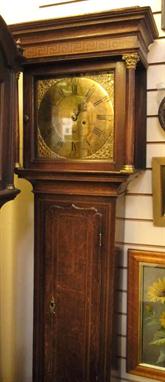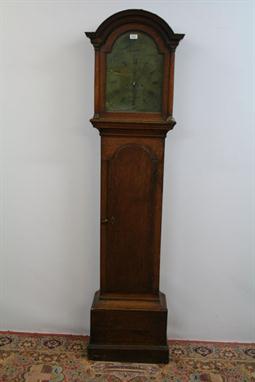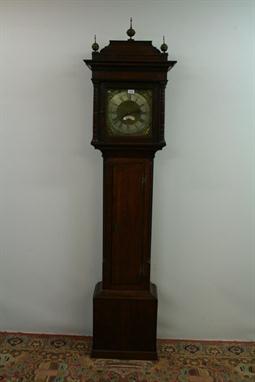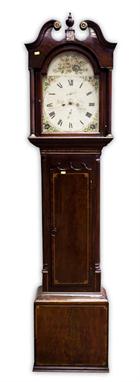We found 44426 price guide item(s) matching your search
There are 44426 lots that match your search criteria. Subscribe now to get instant access to the full price guide service.
Click here to subscribe- List
- Grid
-
44426 item(s)/page
A William & Mary style marquetry inlaid walnut longcase clock, late 19th/early 20th century, the dome moulded top enclosing brass dial flanked by barley twist columns leading to a rectangular case, inlaid with birds and foliage, circular glazed pendulum viewing hole, 188cm high x 32cm wide x 20cm deep. (a/f)
Late eighteenth century longcase clock with eight day movement, twelve inch brass break arch dial with engraved floral spandrels and winged bird on break arch, signed - William Peacock, Kimbolton, subsidiary second dial and calendar aperture in an oak case with full length arched door, domed hood with break arch door and integral plain columns, 197.5cm overall height
Late eighteenth century longcase clock with thirty hour movement, eleven inch square brass dial with classical figure spandrels, silvered chapter ring, signed - John Steel and subsidiary calendar dial, in an oak case with full length door, caddy top hood with turned columns and three ball finials, 221cm overall height
Georgian longcase clock with eight day movement, twelve inch painted break arch dial, signed - J Watkins, Manningtree, painted floral spandrels and landscape scene on break arch, subsidiary seconds dial, in a walnut veneered case with arched door, domed hood with fluted columns, decorative crest and three gold painted ball finials, 230cm overall height
Early nineteenth century longcase clock with thirty hour movement, twelve inch painted break arch dial, signed - Barwife, Cockermouth, painted floral spandrels and subsidiary calendar dial, in a mahogany veneered case with short door, hood with domed door, turned columns, swan-neck pediment and central gold painted ball finial, 210cm overall height
Georgian Irish longcase clock with eight day movement, engraved brass dial with twelve inch brass chapter ring, signed - James Wilson, Belfast, ringed winding holes, subsidiary second hand and calendar aperture. Additional brass break arch extension with dolphin break arch window, now sealed. In a mahogany veneered case with shaped door, break arch hood with fluted columns, swan-neck pediment with carved rosettes and applied central panel with fluted decoration, 225cm overall height
AN EARLY VICTORIAN INLAID MAHOGANY LONGCASE CLOCK THE BREAK ARCHED AND PAINTED DIAL WITH SUBSIDIARY SECONDS DIAL, DATE SECTOR, RINGED WINDING HOLE AND SIGNED STEVENSON NOTTINGHAM HAVING LUNAR WORK TO THE ARCH AND FLORAL SPANDRELS FITTED EIGHT DAY MOVEMENT, THE CASE WITH SWAN NECK PEDIMENT AND FLUTED PILLARS TO THE HOOD
A parquetry inlaid mahogany North Country longcase clock early 19th century, the eight day twin train bell strike movement with anchor escapement, with painted arched Roman dial with moonphase, subsidiary seconds dial and date aperture, pierced engraved brass hands, the spandrels painted with buildings in landscapes, the case with swan`s neck pediment centred by a parquetry architectural surmount, over a parquetry banded frieze and arched glazed door flanked by turned ropetwist columns, the trunk with extensive parquetry banding and conforming columns, 90¼in. (229.5cm.) high, 26¼in. (66.5cm.) wide. * Please note that this clock has been regularly maintained by the Guernsey Clockmakers and is in good working order.
* An early 19th century mahogany longcase clock, the painted dial with swan painted rolling dial, black roman numerals, sweeping second hand by ‘T. C. Clark, Alderstone’, surrouned by images of the Commonwealth, the mahogany case with broken swan neck pediment columns, glazed door, over inlaid shaped hinged door, on plain base, 215cm high. (1)
-
44426 item(s)/page




















































